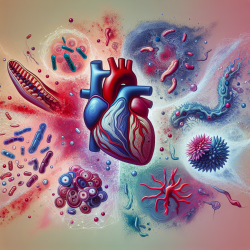Introduction
In the realm of infectious diseases, rare pathogens often present significant challenges for diagnosis and treatment. One such pathogen, Cardiobacterium valvarum, a member of the HACEK group, has recently been highlighted in a case study involving aortic endograft infection and osteomyelitis. This case underscores the importance of recognizing atypical presentations and the role of advanced diagnostic techniques in managing complex infections.
The Case Study
The case involves a 57-year-old male with a history of aortic dissection and subsequent endograft replacement. He presented with back pain, and imaging revealed an infected aortic endograft, vertebral osteomyelitis, and discitis. Blood cultures identified Cardiobacterium valvarum as the causative organism. This rare bacterium, typically associated with infective endocarditis, was treated with ceftriaxone, while surgical intervention was avoided due to anatomical complexities.
Implications for Practice
This case offers several key insights for practitioners:
- Consider Rare Pathogens: In patients with complex medical histories and atypical infection presentations, consider rare pathogens like C. valvarum.
- Utilize Advanced Diagnostics: Techniques such as 16S ribosomal RNA sequencing can be crucial for identifying fastidious organisms that do not grow well in traditional cultures.
- Tailor Treatment Plans: Infections involving prosthetic material, such as endografts, may require prolonged antibiotic therapy and careful consideration of surgical intervention risks.
Encouraging Further Research
The rarity of C. valvarum infections, especially those with extra-cardiac manifestations, highlights the need for further research. Understanding the pathogen's behavior, transmission, and optimal treatment strategies can improve patient outcomes. Researchers are encouraged to explore:
- The epidemiology and pathogenesis of C. valvarum infections.
- Long-term outcomes of patients with C. valvarum infections.
- Potential preventive measures for at-risk populations.
Conclusion
The case of Cardiobacterium valvarum causing aortic endograft infection and osteomyelitis is a reminder of the complexities in diagnosing and managing rare infections. Practitioners should remain vigilant and consider comprehensive diagnostic approaches to ensure accurate identification and effective treatment.
To read the original research paper, please follow this link: An unusual case of Cardiobacterium valvarum causing aortic endograft infection and osteomyelitis.










